Meet the 2025 Make:able Winners
This year’s Make:able Challenge has come to a close—and what a journey it’s been. From thousands of students and makers around the world, we’ve seen a wave of creativity, problem-solving, and empathy, all focused on one mission: to design 3D printed assistive devices that make a real difference.
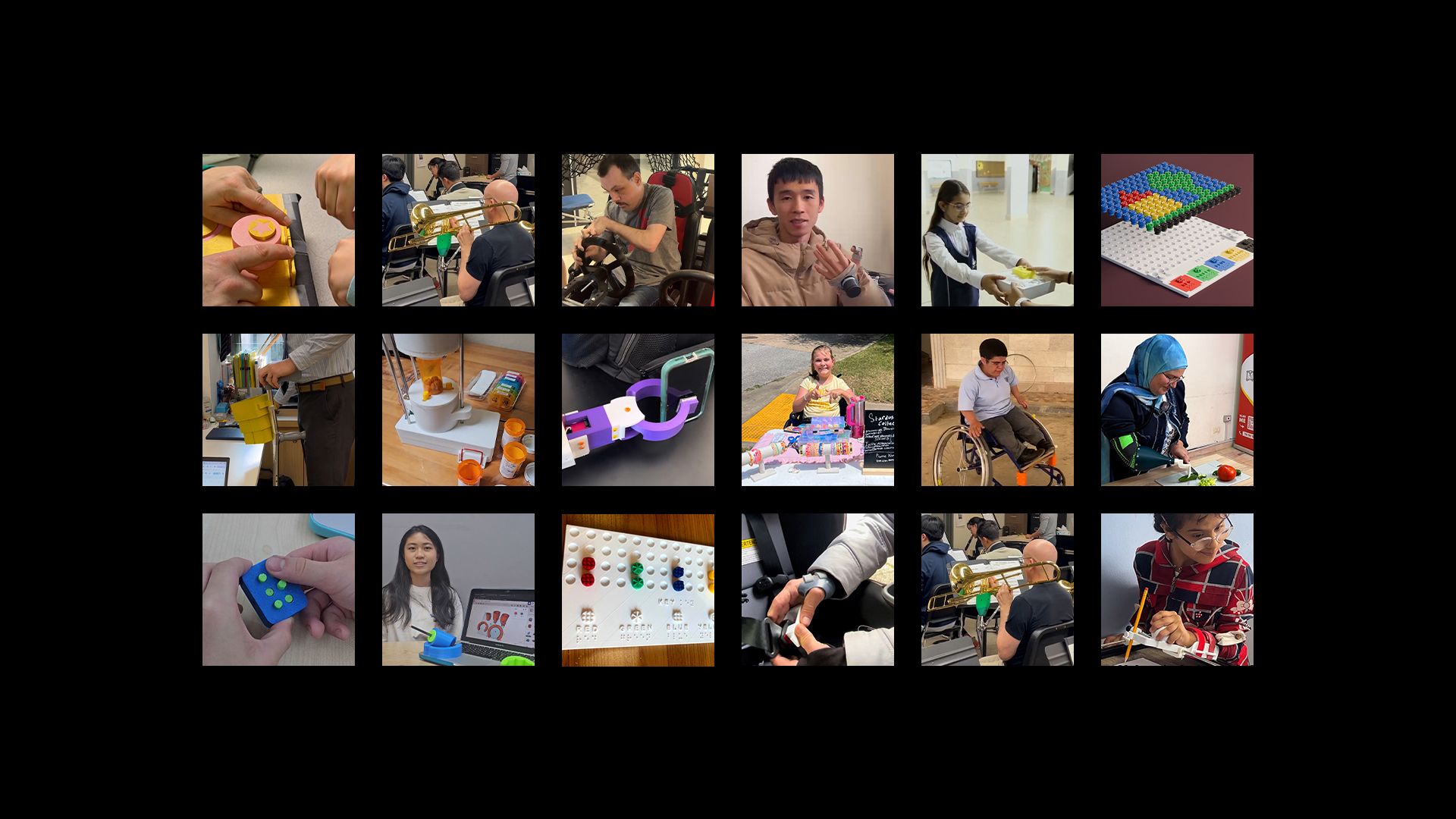
1st July 2025 • News
Before we jump into the results, a few important thank yous:
- To Autodesk, for their continued partnership and for giving the global community access to powerful design tools.
- To our partner organisations and sponsors, whose support helped shape the challenge and fund the prize pool.
- To our judging panel, who took the time to carefully assess this year’s finalists.
- To all the participants, end users, educators, and facilitators—thank you for your commitment, your ideas, and your impact.
The Judging Process
Finalist entries were reviewed on a private judging platform, with each judge assigned a category and asked to select a 1st and 2nd place. Points were awarded (2 for 1st, 1 for 2nd), and the results were tallied to determine the winners.
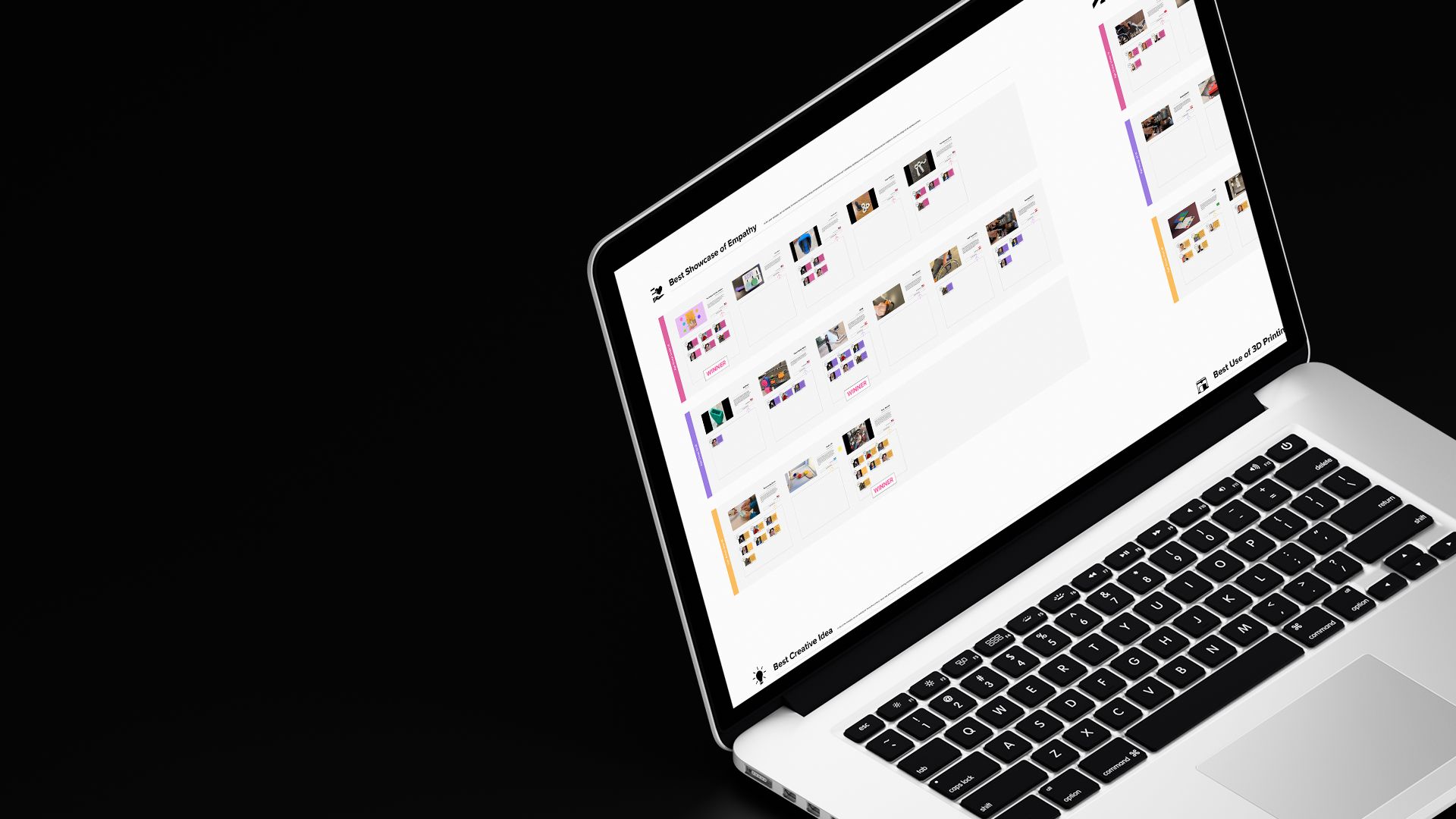
Explore the Results
There are a few ways to experience the winning designs:
- View the full online judging platform with all finalist videos, judge comments, and scores.
- Watch the highlight reel below for a snapshot of this year’s winners.
- Scroll down to see the winner’s list and watch the full video submissions from each winning team.
Best Showcase of Empathy (Under 14)
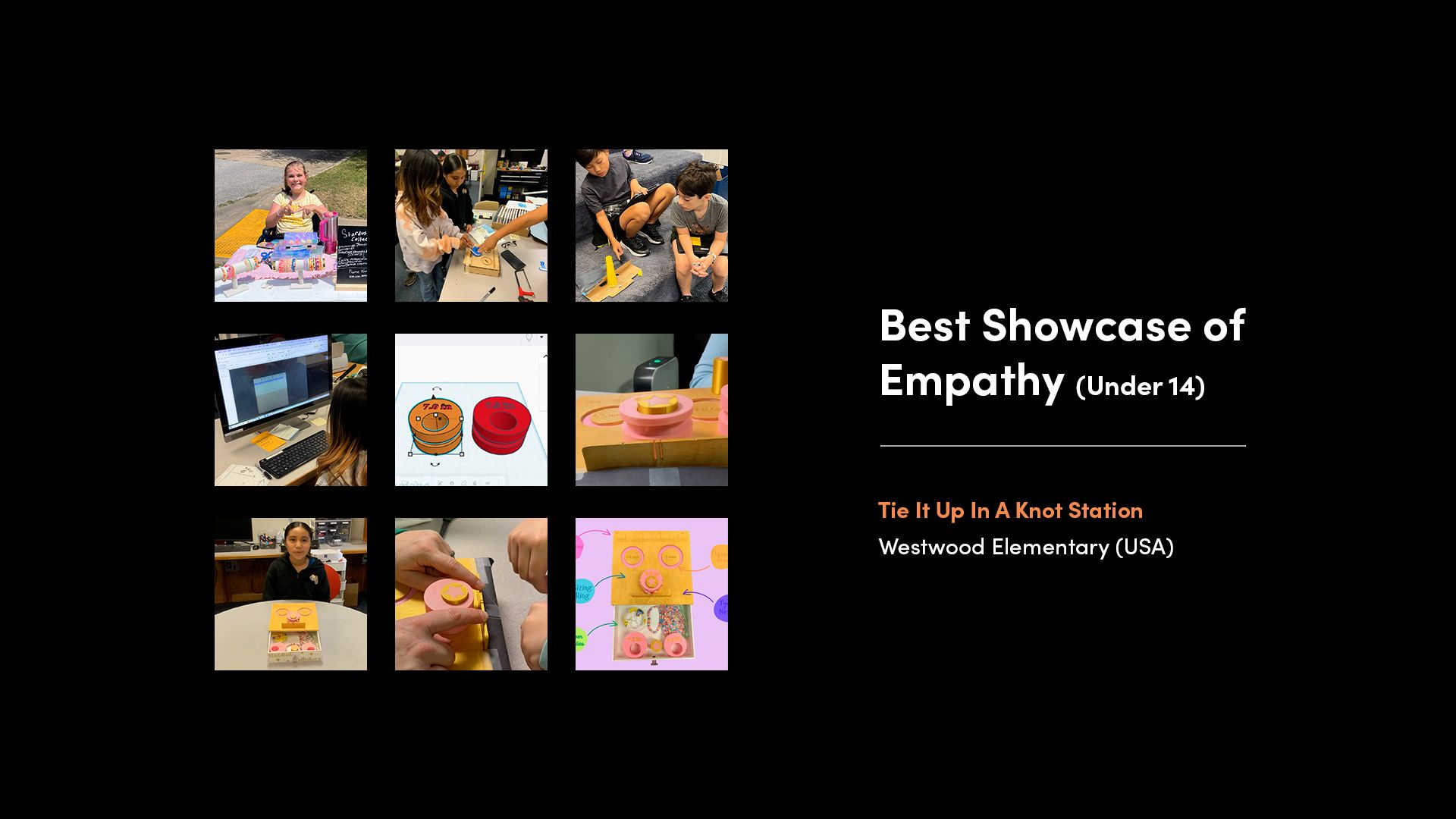
The winners of ‘Best Showcase of Empathy’ for the under 14 age group is Tie It Up In A Knot Station from Westwood Elementary (USA), who will receive a Bambu Lab P1S Combo 3D printer (from MatterHackers). The Tie It Up Station enables a young entrepreneur with limited hand mobility to independently tie knots for her handmade bracelet business. What began as a simple cardboard prototype evolved into a durable, user-friendly tool—empowering her with greater accessibility and support in growing her business.
View Submission
Best Showcase of Empathy (14-18)
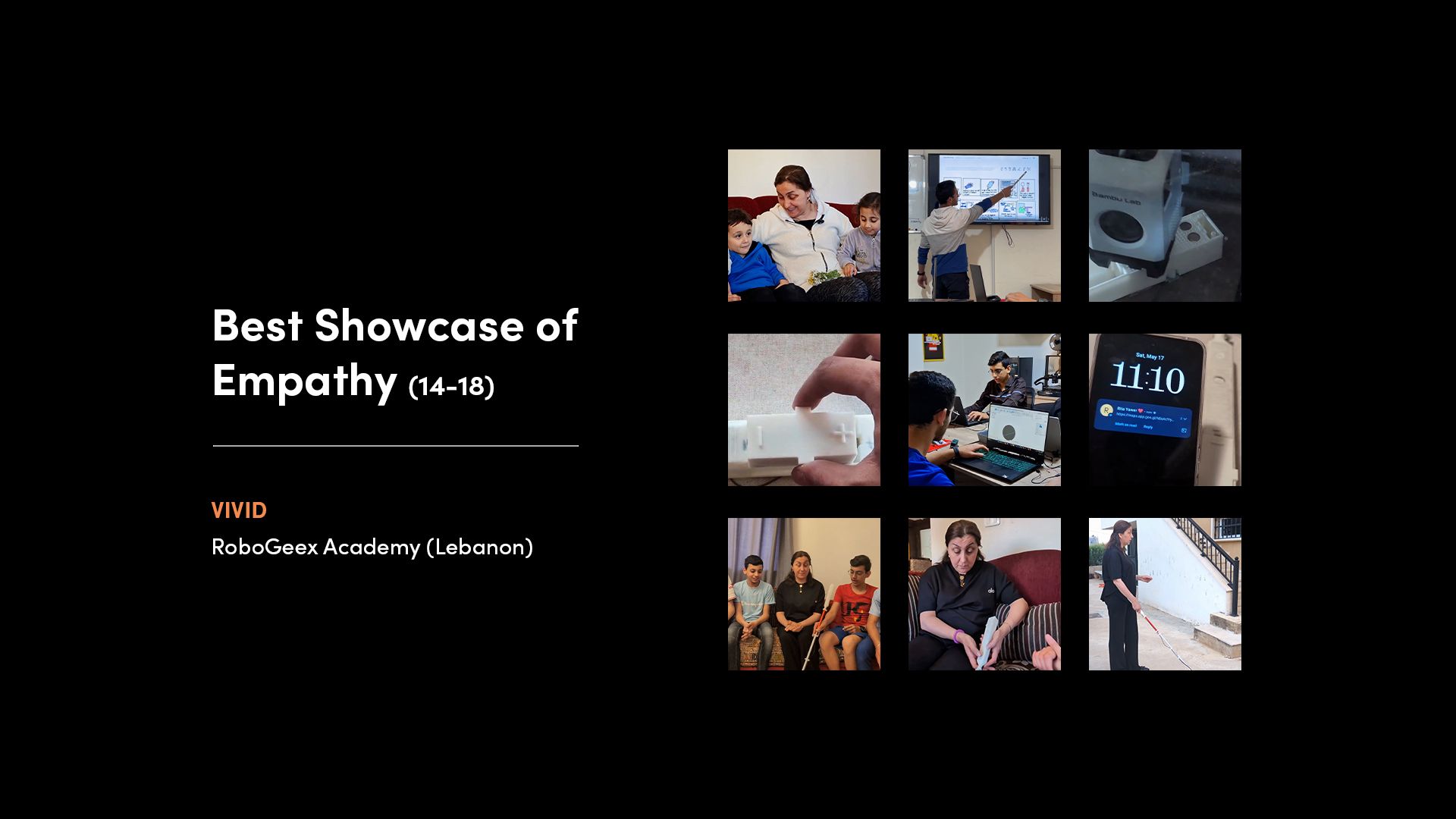
The winners of ‘Best Showcase of Empathy’ for the 14-18 age group is VIVID from RoboGeex Academy (Lebanon), who will receive a Bambu Lab P1S Combo 3D printer (from MatterHackers). Team VIVID designed a smart cane for Safaa, a blind woman who often feels unsafe when alone. The cane features a distance sensor with vibration feedback for obstacle detection, plus two emergency buttons to send an SMS, make a call, and share her location. Through multiple iterations, the team improved strength, added a detachable charging station, and refined the interface for greater safety and usability.
View Submission
Best Showcase of Empathy (Over 18)
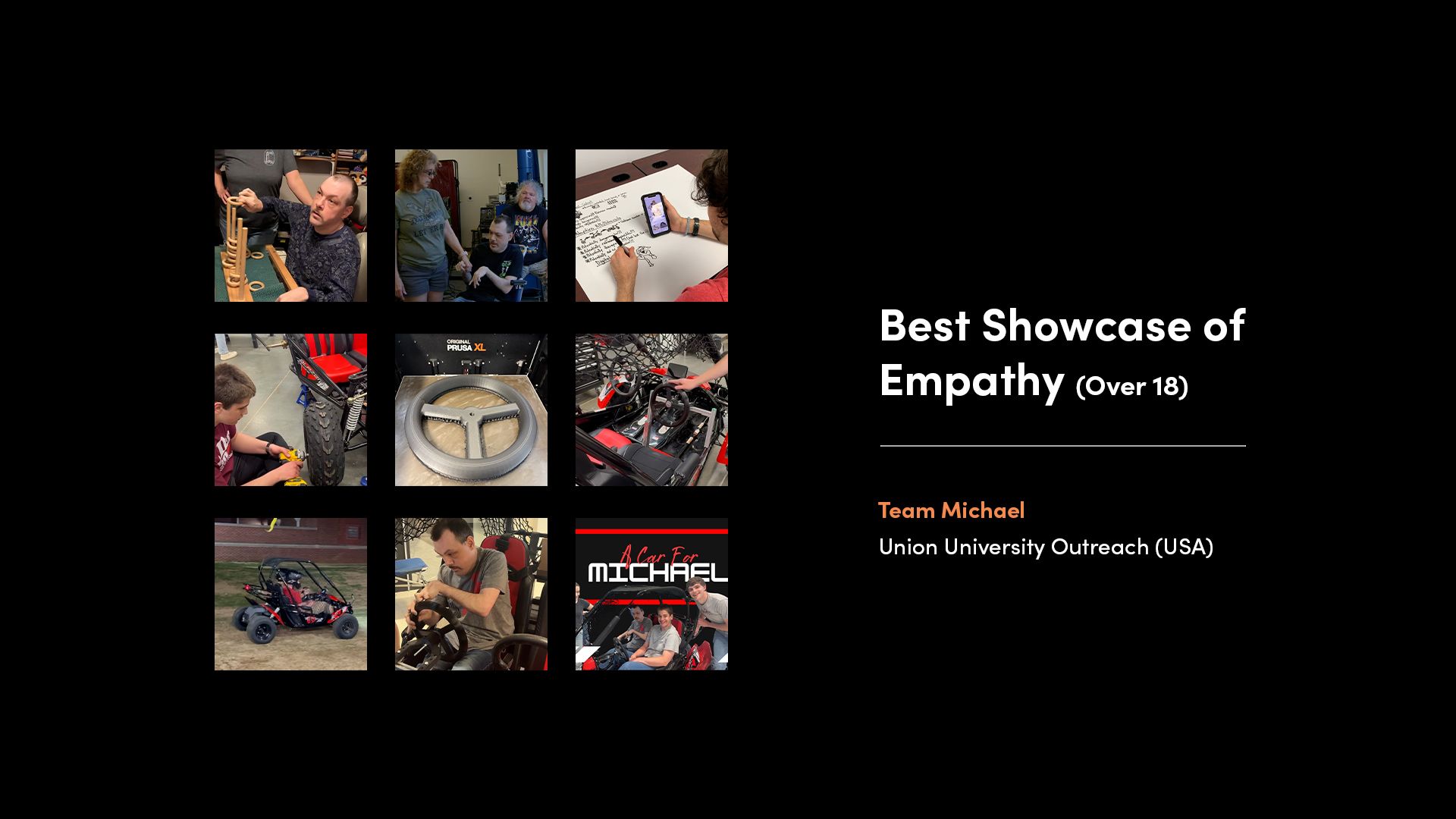
The winners of ‘Best Showcase of Empathy’ for the over 18 age group is Team Michael from Union University Outreach (USA), who will receive a $500 Gift Card (from Autodesk). Team Michael adapted a go-kart experience for their end user, Michael, who has cerebral palsy, is blind, and has limited mobility. To give him the joy of riding safely outdoors, they added protective netting and a fake steering wheel in the passenger seat—allowing him to feel like he’s driving. After speaking with Michael’s family, the team learned he rarely spends time outside, so their solution was designed to offer a fun, inclusive, and engaging outdoor experience.
View Submission
Best Creative Idea (Under 14)
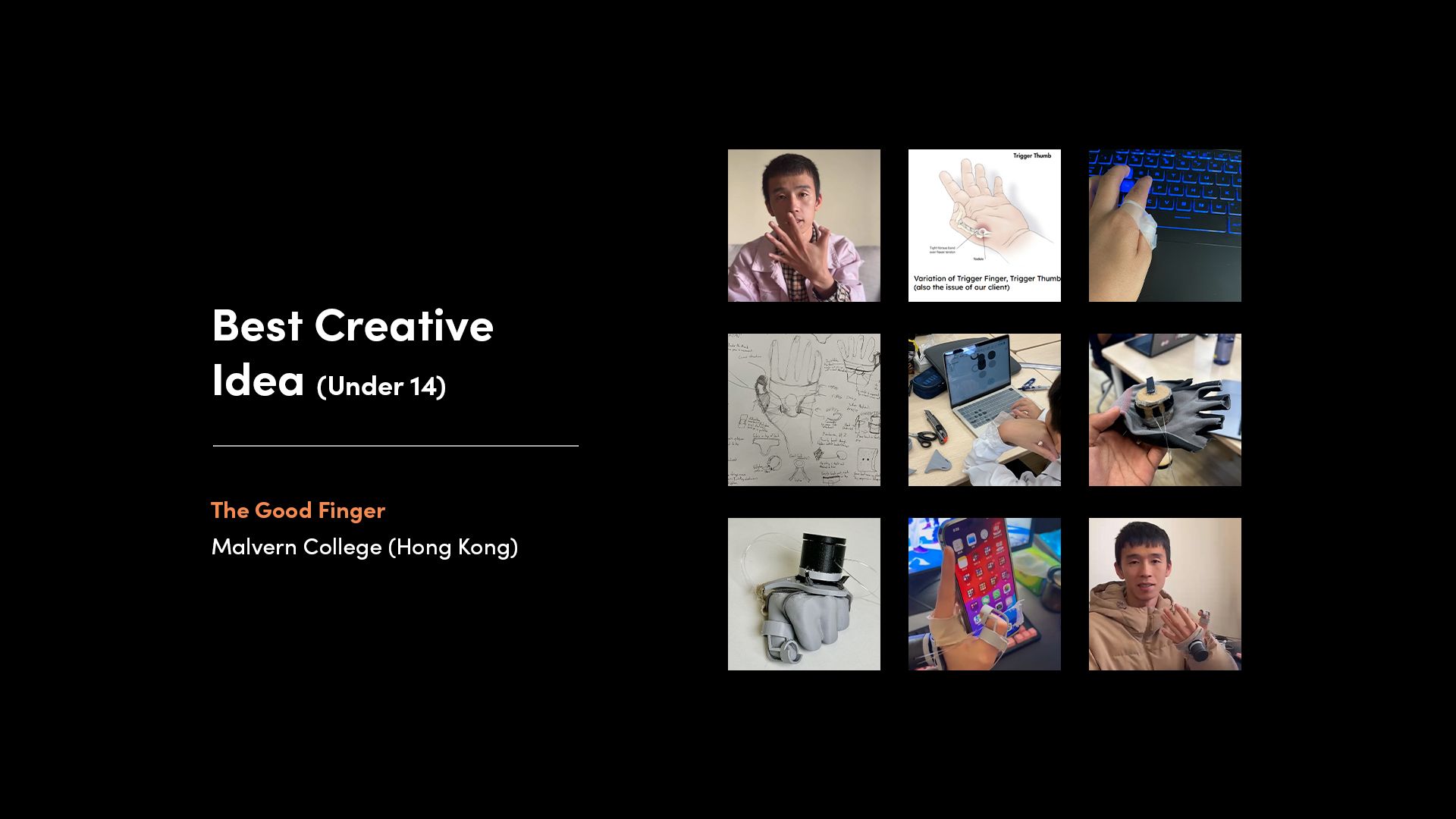
The winners of ‘Best Creative Idea’ for the under 14 age group is The Good Finger from Malvern College (Hong Kong), who will receive a MH Build “The Works!” Filament Bundle Pack (from MatterHackers). The Good Finger designed a combined thumb stabiliser and grip aid for their end user, Wu Lei—a former police officer whose thumb is locked at a 90-degree angle due to trigger finger. The device features a thumb support and a string-based tension mechanism, allowing him to twist a cylinder to adjust the grip. It’s a clever solution with potential for further refinement to make it more discreet when worn.
View Submission
Best Creative Idea (14-18)
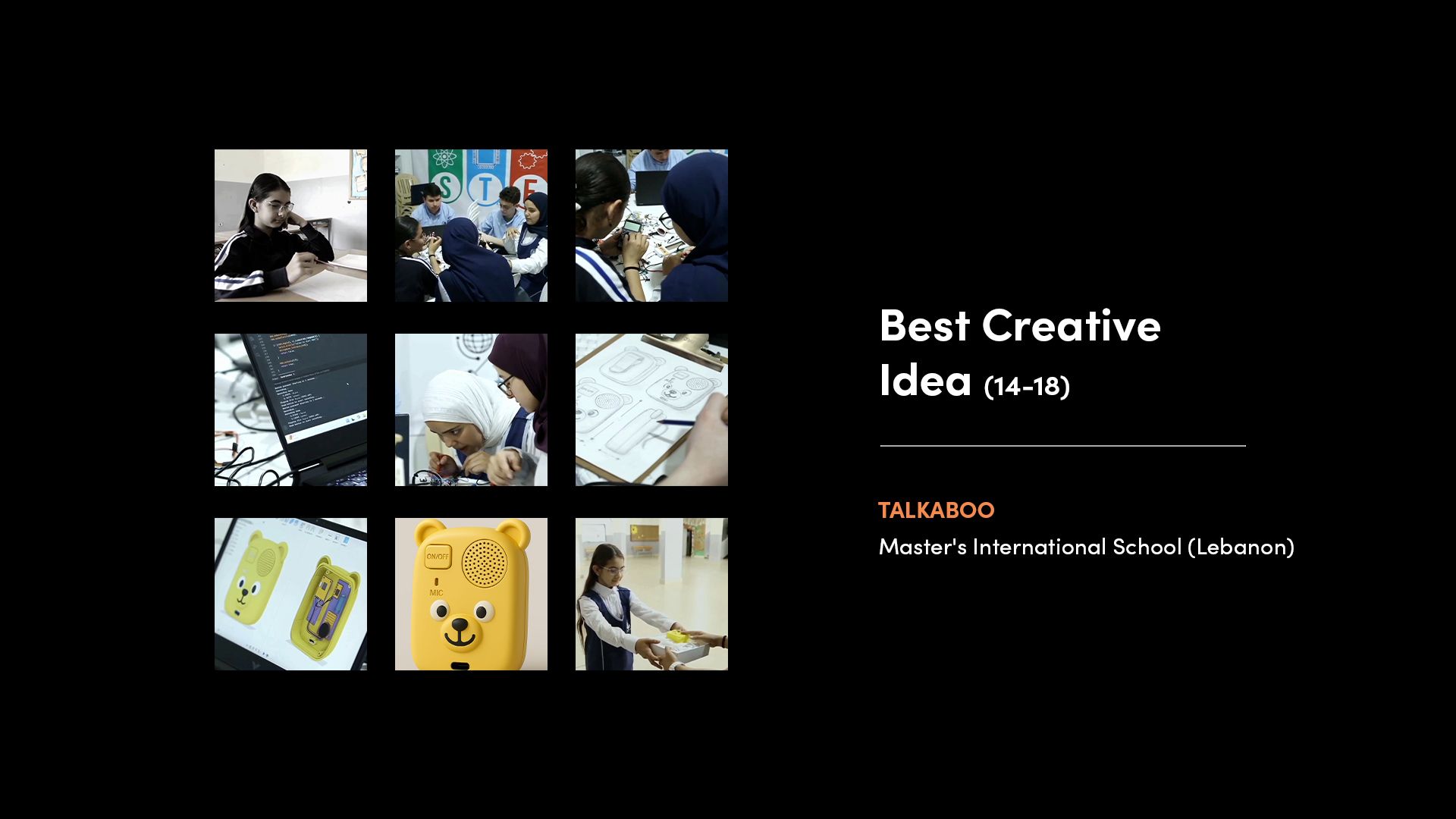
The winners of ‘Best Creative Idea’ for the 14-18 age group is TALKABOO from Master’s International School (Lebanon), who will receive a MH Build “The Works!” Filament Bundle Pack (from MatterHackers). Team TALKABOO created an interactive educational device that uses AI to convert unclear speech from children with speech sound disorders into clear pronunciation. Built with an Arduino Nano 33 BLE, microphone, speaker, and playback module, the device is enclosed in a colourful, 3D-printed bear—designed in Autodesk Fusion to be both functional and playful, making speech practice engaging and confidence-building.
View Submission
Best Creative Idea (Over 18)
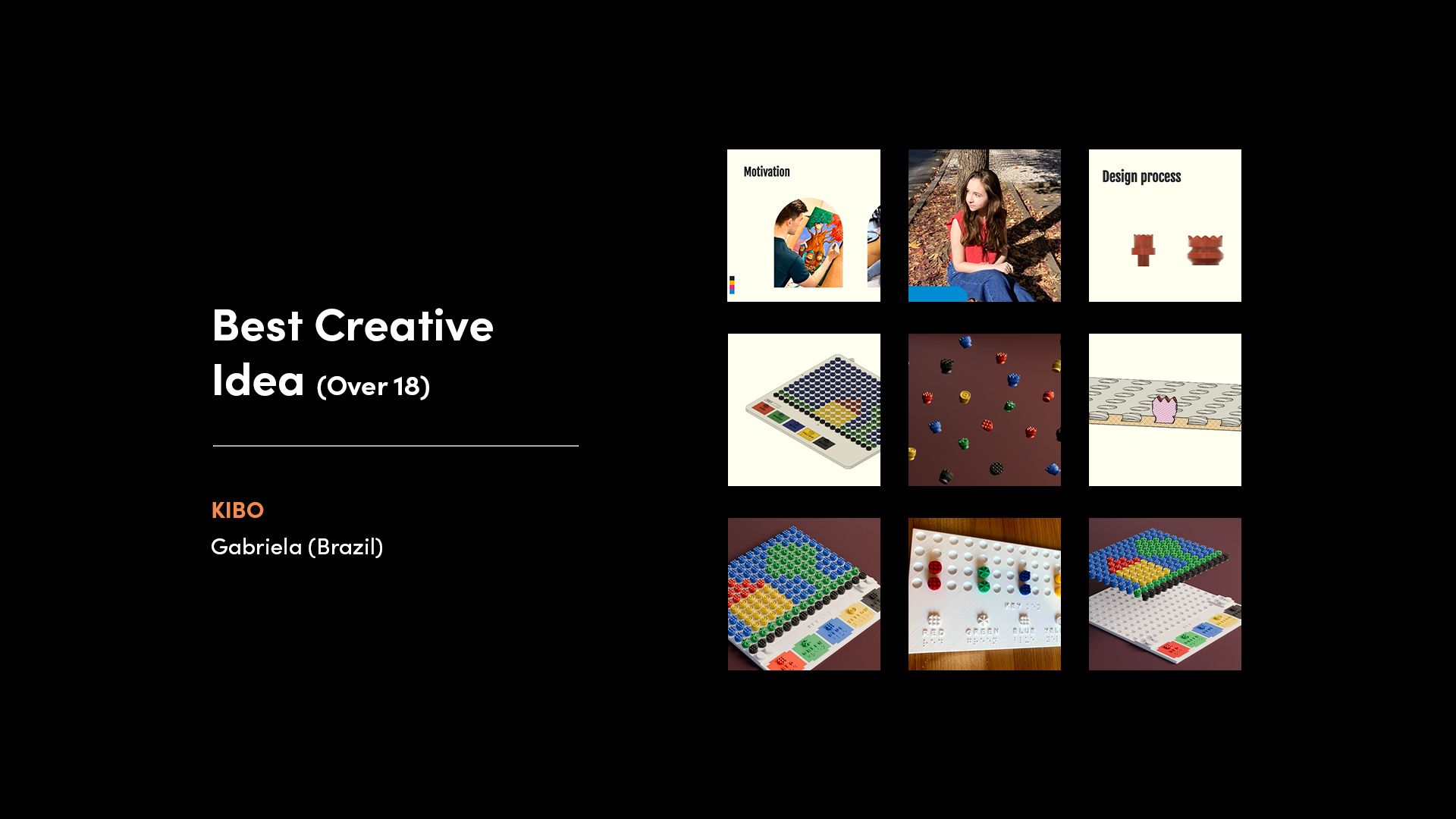
The winners of ‘Best Creative Idea’ for the over 18 age group is KIBO by Gabriela da Silva (Brazil), who will receive a $500 Gift Card (from Autodesk). KIBO is a 3D-printed art board designed to make creative expression more accessible for visually impaired children. Users screw textured, colour-coded bolts into a grid to form tactile designs—each texture representing a different colour, with a braille key for reference. The team made clever use of threading in Fusion and produced high-quality renders and animations to showcase their modular, print-ready design.
View Submission
Best Use of Autodesk Software (Under 14)
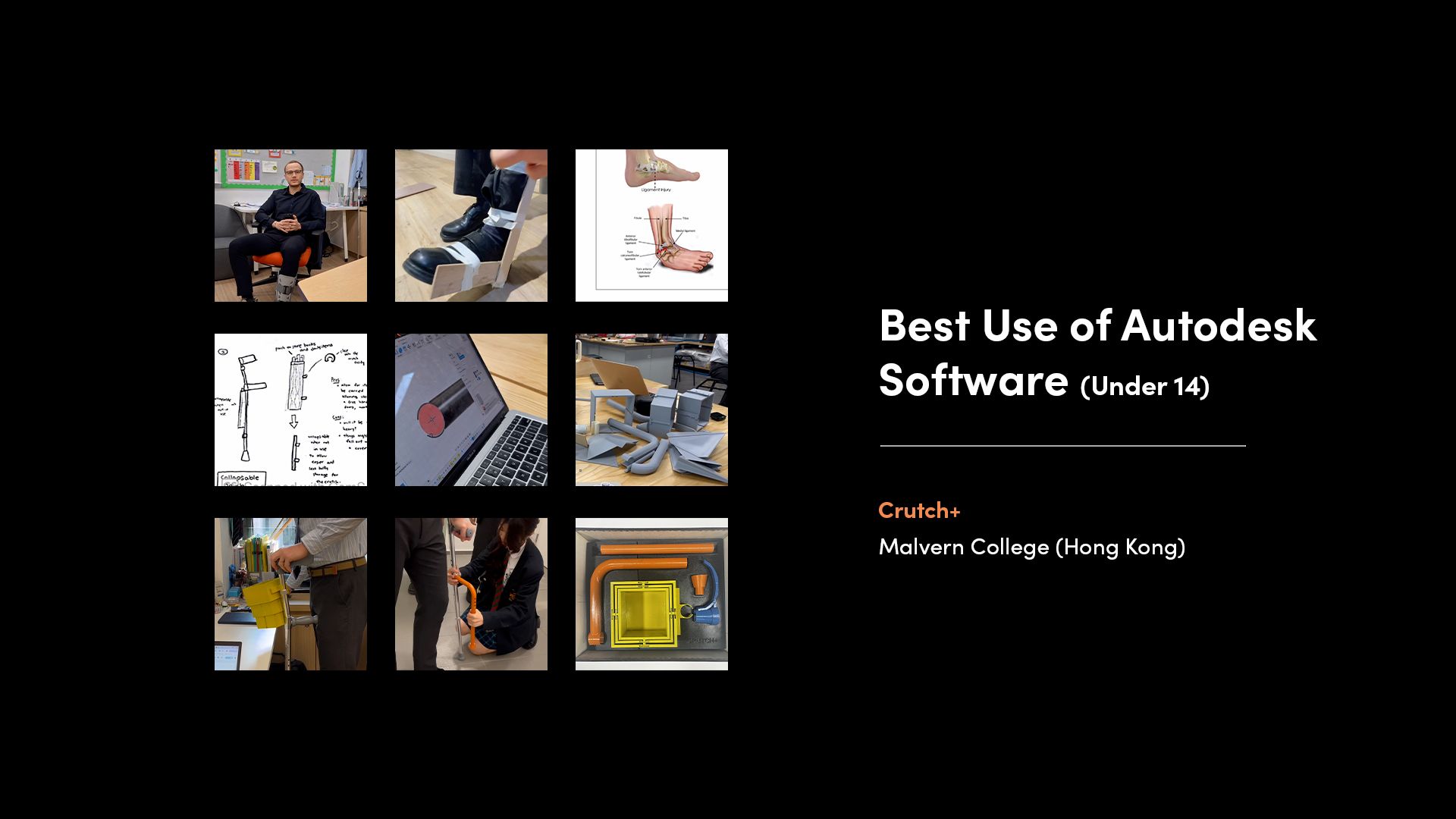
The winners of ‘Best Use of Autodesk Software’ for the under 14 age group is Crutch+ from Malvern College (Hong Kong), who will receive an Ultimaker 2 Go 3D Printer. Team Crutch+ developed a multi-functional toolbox of attachments for Mr Scott, a primary school teacher recovering from a partial ligament tear. Designed to fit onto his existing crutch, the attachments support everyday tasks such as opening doors, climbing stairs, and carrying small items. The team used finite element analysis in Autodesk Fusion to test the stair support under load, and engineered a collapsible storage box with a custom 3D-printed mechanism.
View Submission
Best Use of Autodesk Software (14-18)
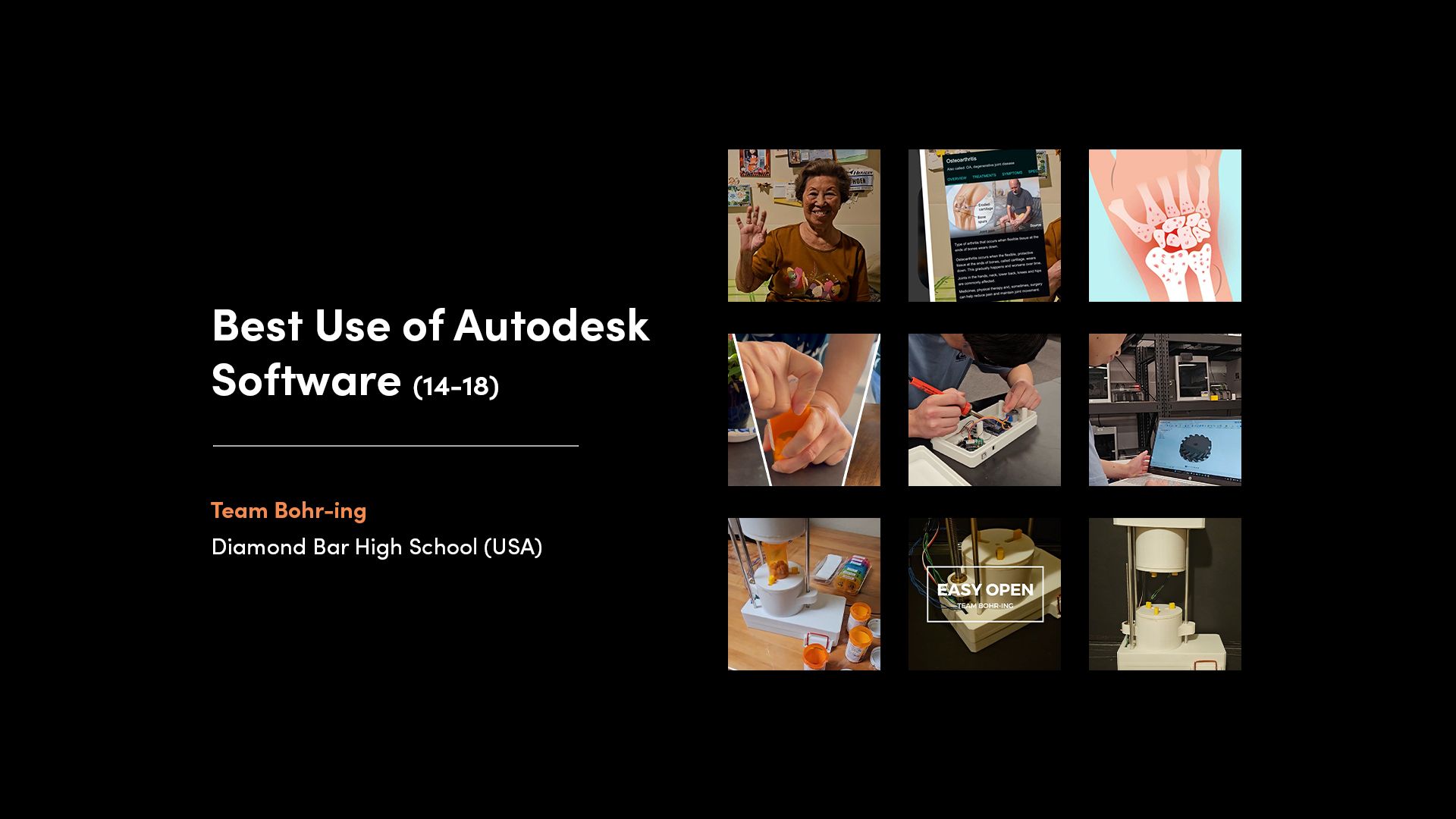
The winners of ‘Best Use of Autodesk Software’ for the 14-18 age group is Team Bohr-ing from Diamond Bar High School (USA), who will receive an Ultimaker 2 Go 3D Printer. Team Bohr-ing developed Easy Open, a motorised countertop device that helps their end user, Siok Wah—who has osteoarthritis—open child-resistant medicine bottles with ease. It mimics the required motions and includes an RFID system for safe use. The team explored multiple iterations using Autodesk Fusion and 3D printing to refine their design.
View Submission
Best Use of Autodesk Software (Over 18)
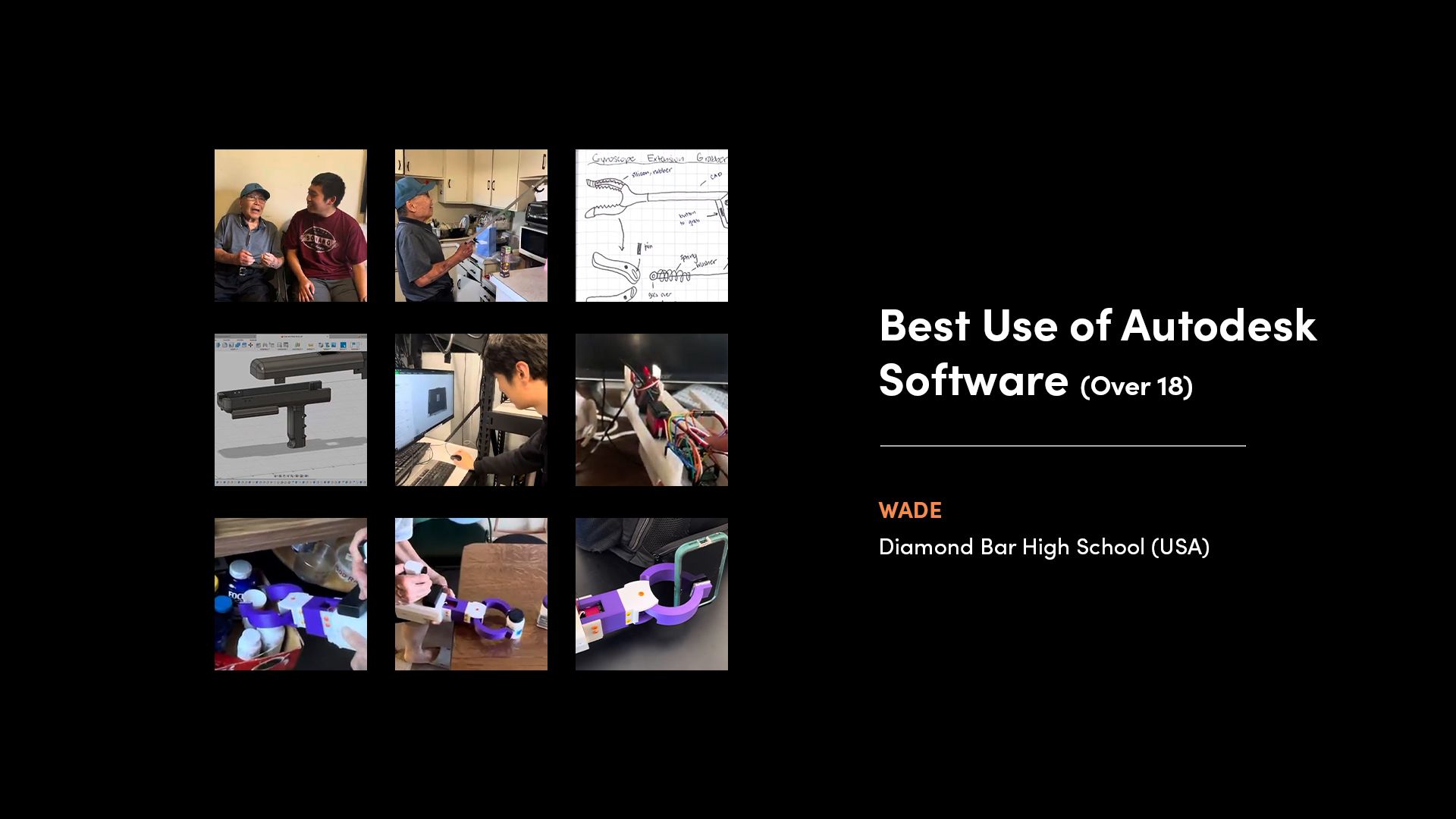
The winners of ‘Best Use of Autodesk Software’ for the over 18 age group is WADE from Diamond Bar High School (USA), who will receive a $500 gift card (from Autodesk). Team WADE designed a motorised grabber tool for a team member’s grand-uncle, who has arthritis and hand tremors that make it difficult to pick up objects. The device features a bevel gearbox-operated jaw controlled by a button, along with a motorised counterweight system that senses tilt and adjusts to stabilise the tool during use. The team modelled the full assembly in Fusion, combining mechanical precision with thoughtful user-focused design.
View Submission
Best Showcase of Customisation (Under 14)
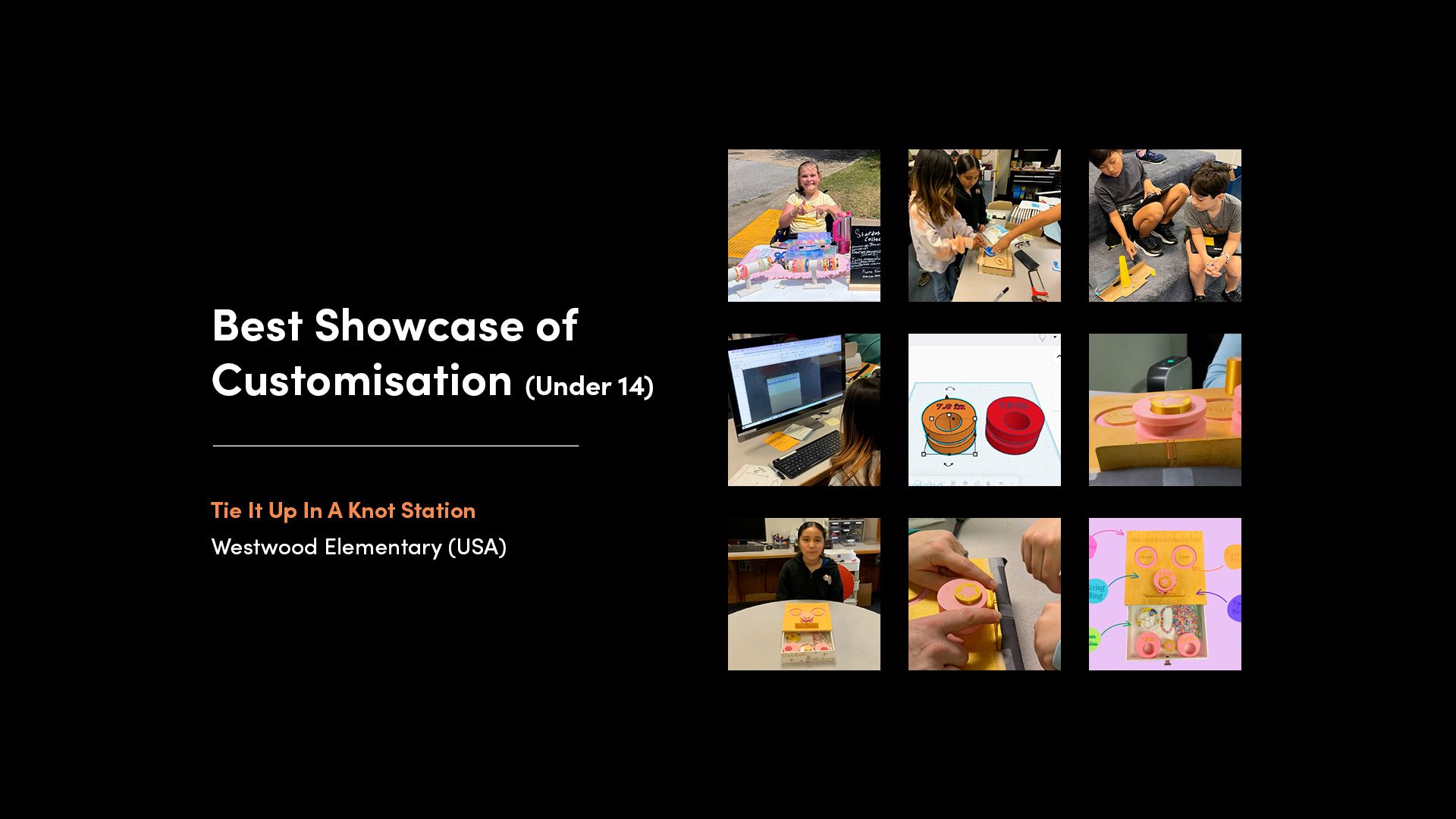
The winners of ‘Best Showcase of Customisation’ for the under 14 age group is Tie It Up In A Knot Station from Westwood Elementary (USA), who will receive an EinStar 3D Scanner (from Shining3D). The Tie It Up Station enables a young entrepreneur with limited hand mobility to independently tie knots for her handmade bracelet business. What began as a simple cardboard prototype evolved into a durable, user-friendly tool—empowering her with greater accessibility and support in growing her business.
View Submission
Best Showcase of Customisation (14-18)
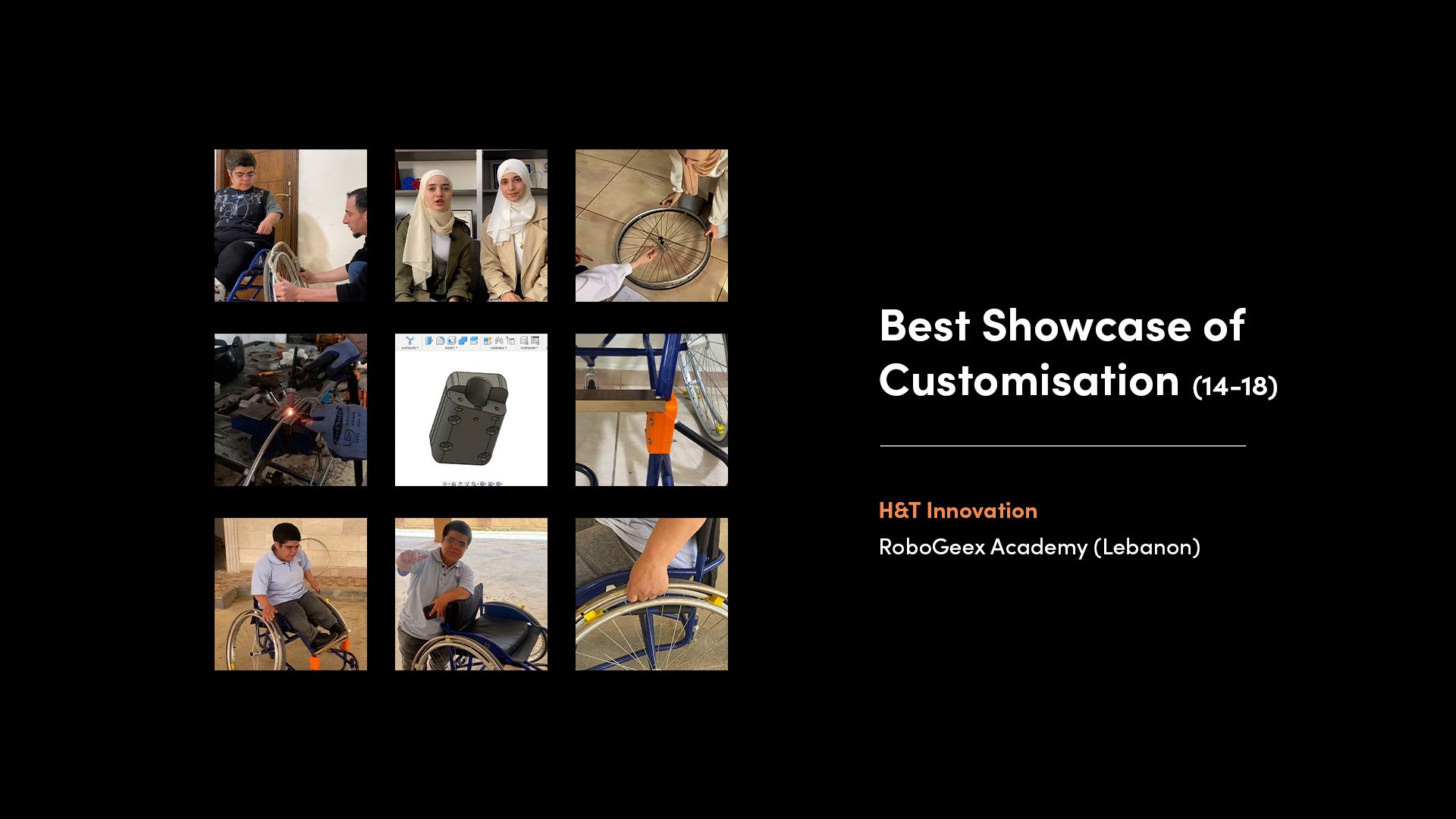
The winners of ‘Best Showcase of Customisation’ for the 14-18 age group is H&T Innovation from RoboGeex Academy (Lebanon), who will receive an EinStar 3D Scanner (from Shining3D). Team H&T Innovation developed a customised wheelchair modification for Manar, a 42-year-old basketball player with dwarfism. They enlarged and repositioned her existing wheelchair rim to bring it closer to her hands, making it easier to manoeuvre without bending down. Two 3D-printed components were also added to support a wooden foot platform, enhancing stability during play. The solution is precisely tailored to Manar’s body and wheelchair.
View Submission
Best Showcase of Customisation (Over 18)
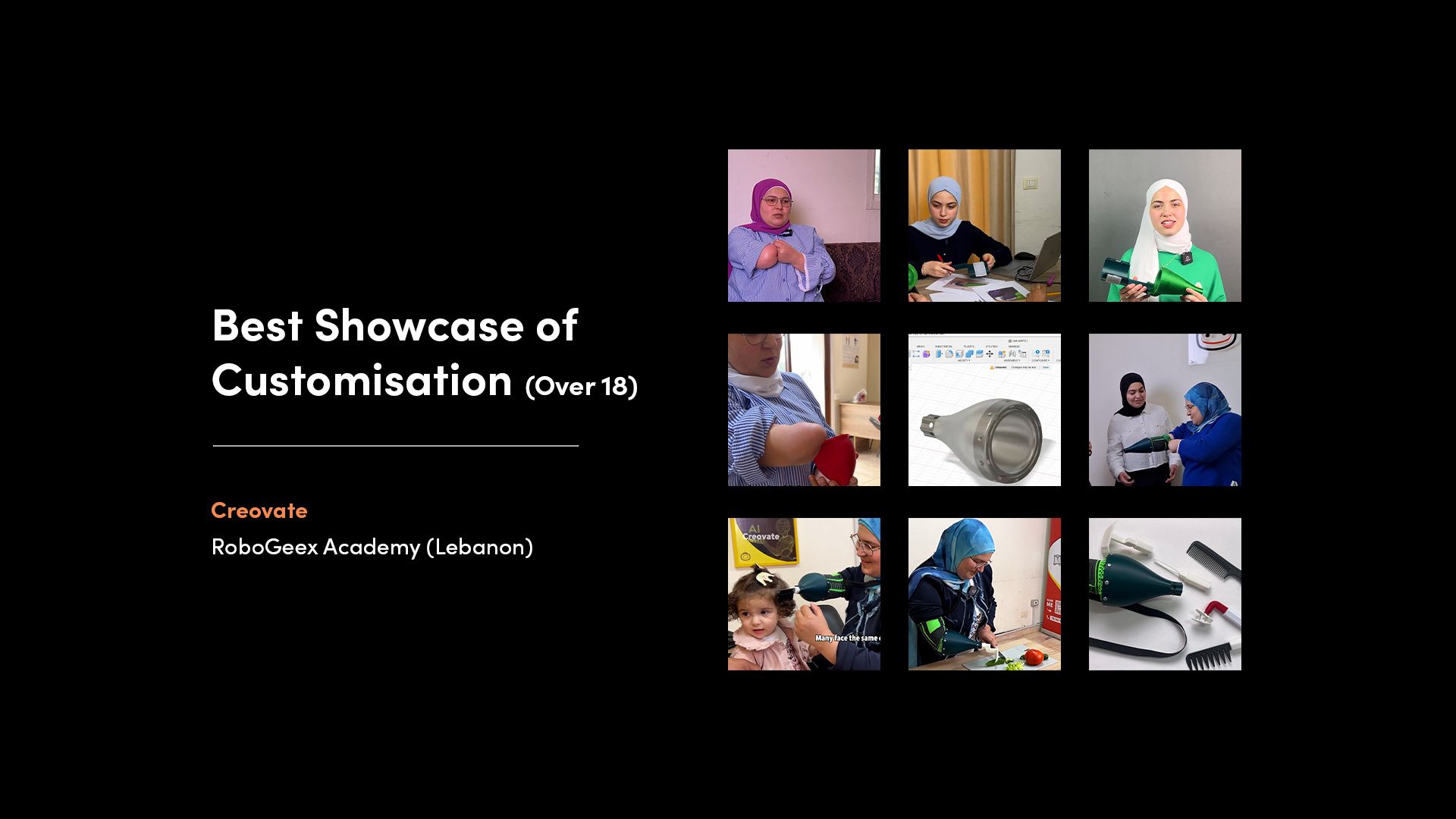
The winners of ‘Best Showcase of Customisation’ for the over 18 age group is Creovate from RoboGeex Academy (Lebanon), who will receive a $500 gift card (from Autodesk). Team Creovate designed a lightweight, multi-functional assistive device for Karima, a mother with partial arm loss, to support her in daily tasks like brushing her daughter Jouri’s hair and preparing meals. The 3D-printed device features interchangeable, custom-designed attachments—including a hairbrush tool, zipper puller, food prep aid, and buttoning tool. Rather than focusing on a full hand prosthetic, the team prioritised comfort, freedom of movement, and tailored solutions to Karima’s everyday needs.
View Submission
Best Use of 3D Printing (Under 14)
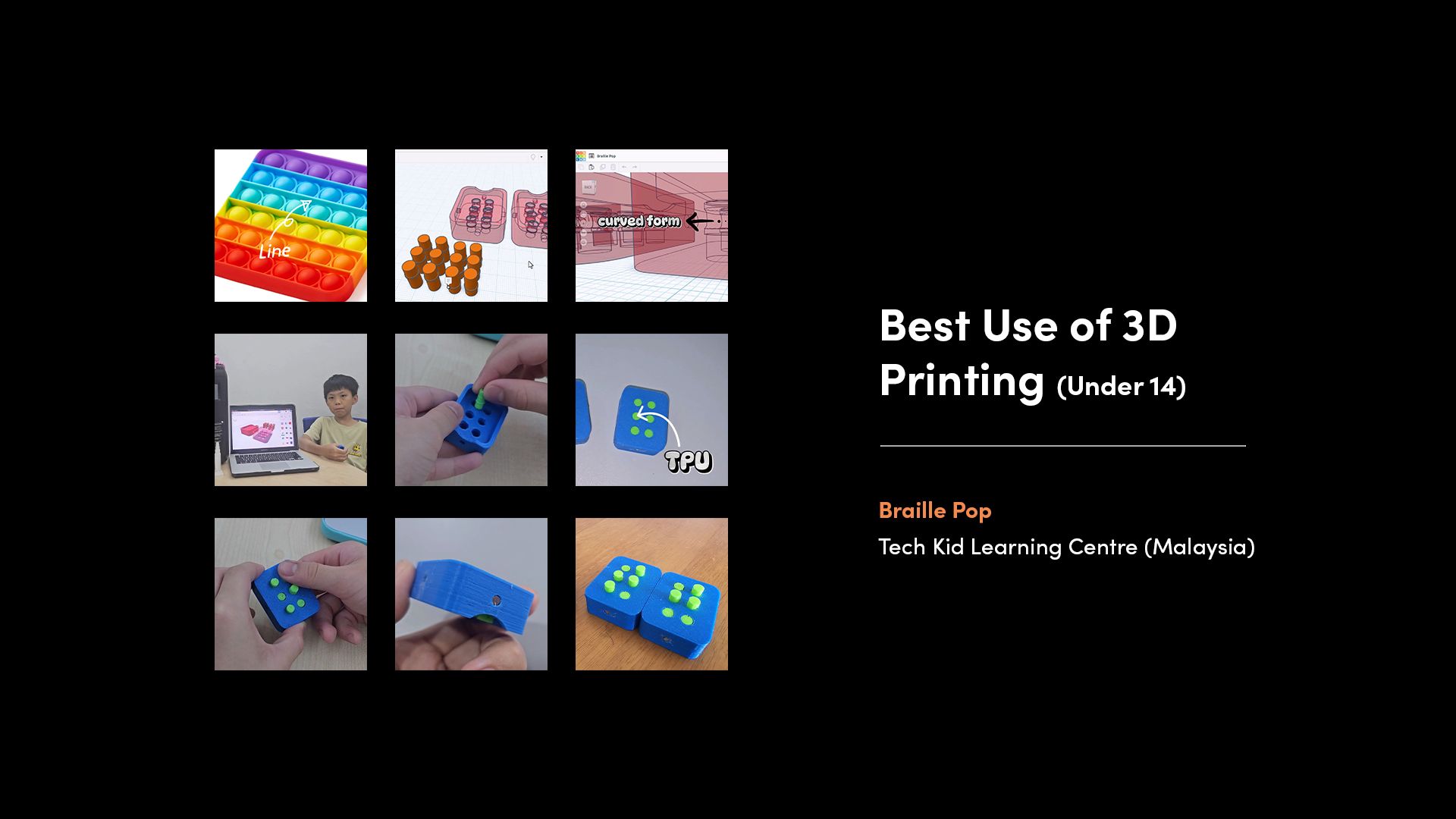
The winners of ‘Best Use of 3D Printing’ for the under 14 age group is Braille Pop from Tech Kid Learning Centre (Malaysia), who will receive an Original Prusa MINI+ Semi-assembled 3D Printer (from Prusa Research). Braille Pop is a modular braille-learning fidget inspired by Pop It toys. Each unit features a soft, tactile popping mechanism with Braille characters made from TPU filament, and magnets on each side allow them to connect—so users can spell out words. It works as both an educational tool and a sensory fidget.
View Submission
Best Use of 3D Printing (14-18)
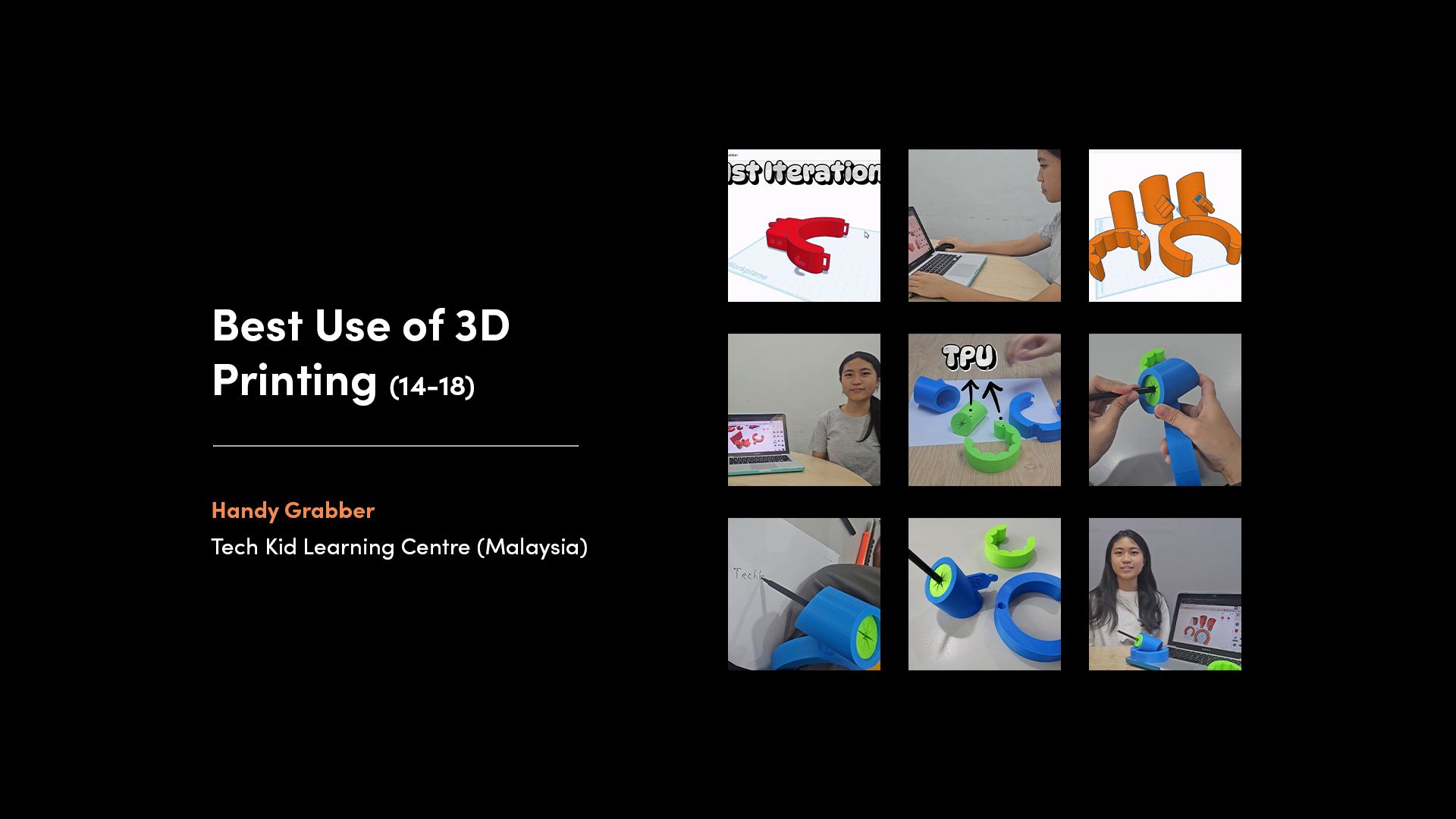
The winners of ‘Best Use of 3D Printing’ for the 14-18 age group is Handy Grabber from Tech Kid Learning Centre (Malaysia), who will receive an Original Prusa MINI+ Semi-assembled 3D Printer (from Prusa Research). The Handy Grabber is a 3D printed assistive device that allows individuals without lower arms to hold and use stationery items independently. It features a modular design with a comfortable TPU cuff that wraps around the bicep, and a star-shaped TPU pen holder that securely grips various writing tools. The flexible material ensures both comfort and functionality, and the modular system allows for interchangeable connectors to suit different tasks.
View Submission
Best Use of 3D Printing (Over 18)
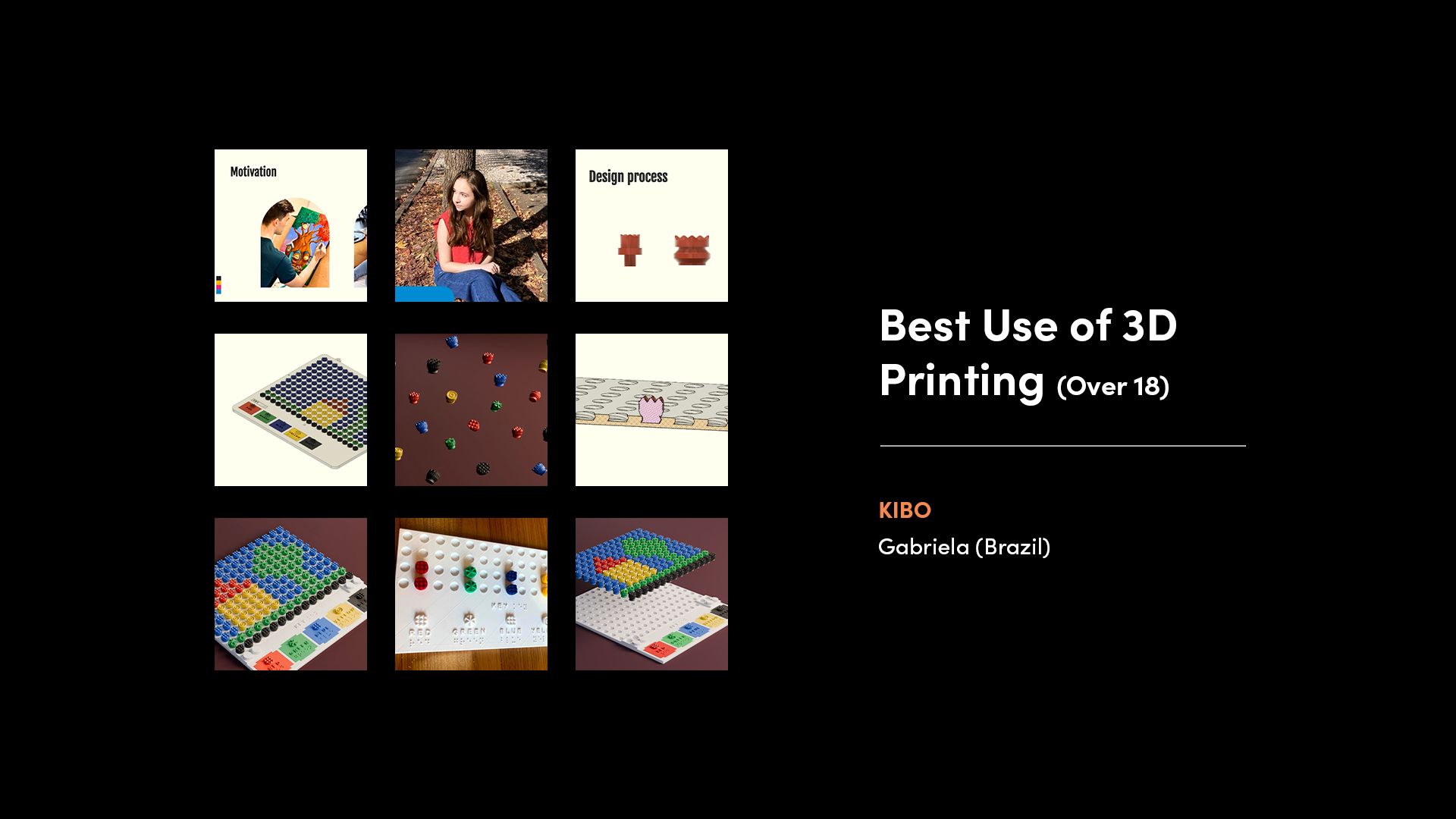
The winners of ‘Best Use of 3D Printing’ for the over 18 age group is KIBO by Gabriela da Silva (Brazil), who will receive a $500 Gift Card (from Autodesk). KIBO is a 3D-printed art board designed to make creative expression more accessible for visually impaired children. Users screw textured, colour-coded bolts into a grid to form tactile designs—each texture representing a different colour, with a braille key for reference. The team made clever use of threading in Fusion and produced high-quality renders and animations to showcase their modular, print-ready design.
View Submission
Best Showcase of Iterative Design (Under 14)
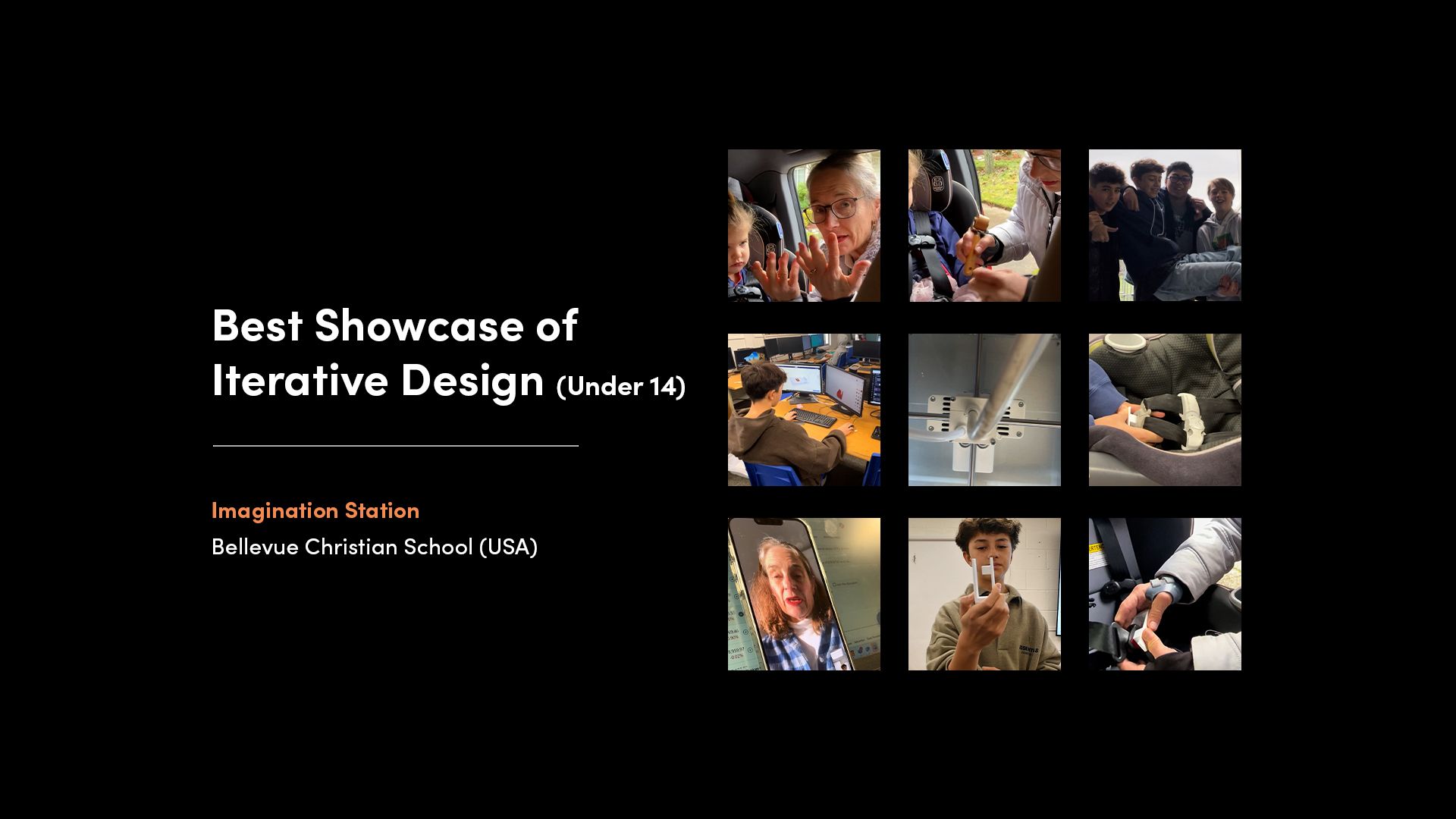
The winners of ‘Best Showcase of Iterative Design’ for the under 14 age group is Imagination Station from Bellevue Christian School (USA), who will receive a Bambu Lab A1 Mini 3D Printer (from CREATE Education). Team Imagination Station designed a device to help Megan’s grandmother, Dorie, who has arthritis, open a child car seat buckle more easily. By exploring a wide range of ideas through divergent thinking and testing over five iterations, the team arrived at a solution that makes everyday tasks safer and more manageable.
View Submission
Best Showcase of Iterative Design (14-18)
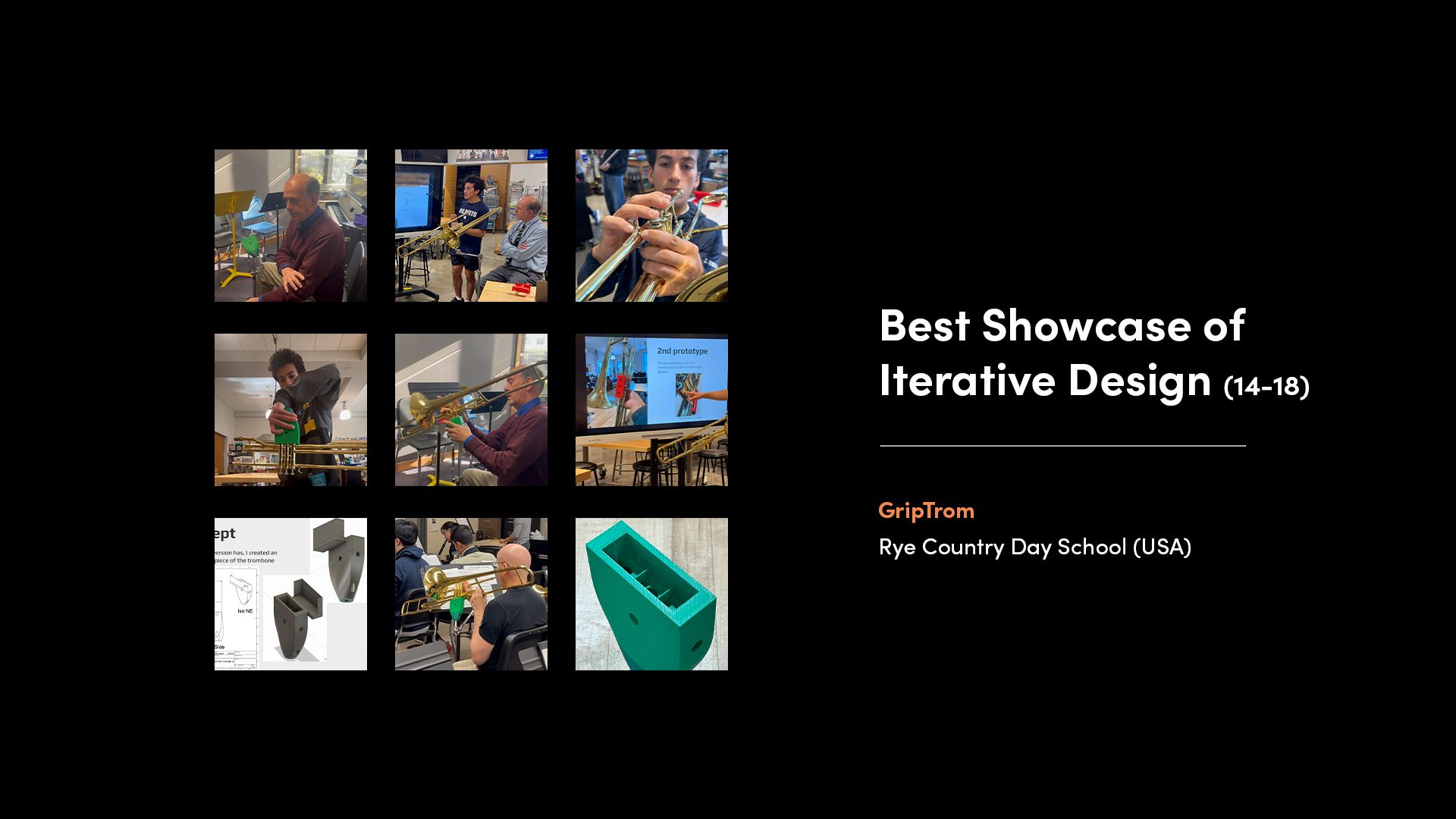
The winners of ‘Best Showcase of Iterative Design’ for the 14-18 age group is GripTrom from Rye Country Day School (USA), who will receive a Bambu Lab A1 Mini 3D Printer (from CREATE Education). GripTrom is a 3D-printed assistive device designed to help high school music teachers Mr Haeger and Mr Ragusa play trombone without the pain caused by arthritis. Existing solutions didn’t meet their needs, so the team created a lightweight, adjustable holder that mounts to a cymbal stand—offering hands-free support. Multiple iterations were made to refine the form and thread connection, ensuring a safe and reliable design that restores comfort and performance.
View Submission
Best Showcase of Iterative Design (Over 18)
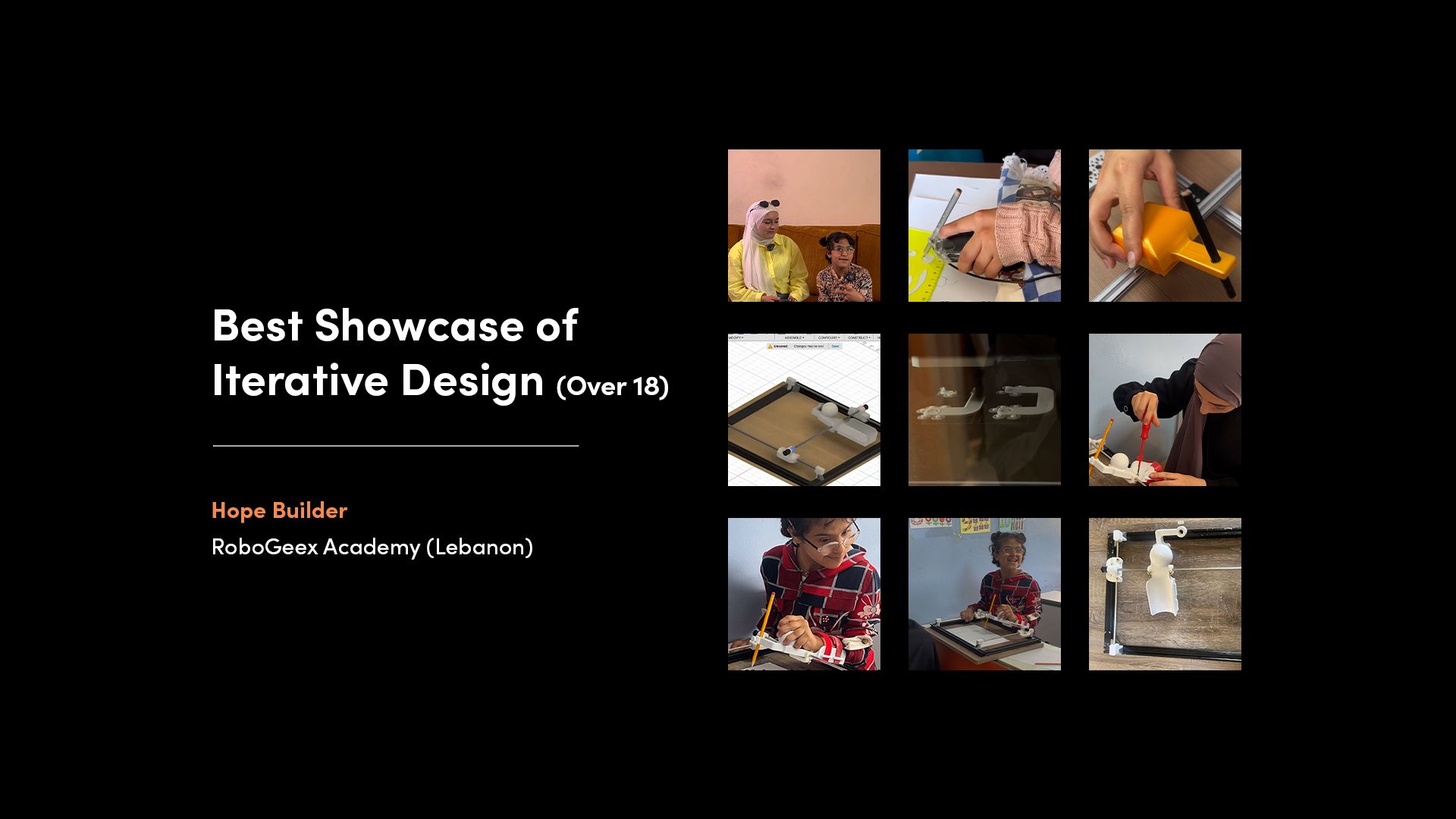
The winners of ‘Best Showcase of Iterative Design’ for the over 18 age group is Hope Builder from RoboGeex Academy (Lebanon), who will receive a $500 gift card (from Autodesk). Team Hope Builder designed a writing aid for Domoaa, a 10-year-old with left-sided hemiplegia, to help her write more easily and confidently at school. The device features an aluminium frame, linear guide rails for smooth movement, and a stabilising module that holds a pen and supports her hand. After testing various concepts—including stencils and mouse-like tools—the team used Autodesk Fusion to simulate motion and refine their final design, adding a mechanical brake for improved control and comfort.
View Submission
Take Part in 2026
Inspired to join the next challenge? Registration for Make:able 2026 is now open. Visit makeablechallenge.com to learn more and get started—for free. A refreshed toolkit will launch in November 2025, with added resources while keeping the challenge format the same. Questions? Email us anytime at hello@weareprintlab.com 🙂